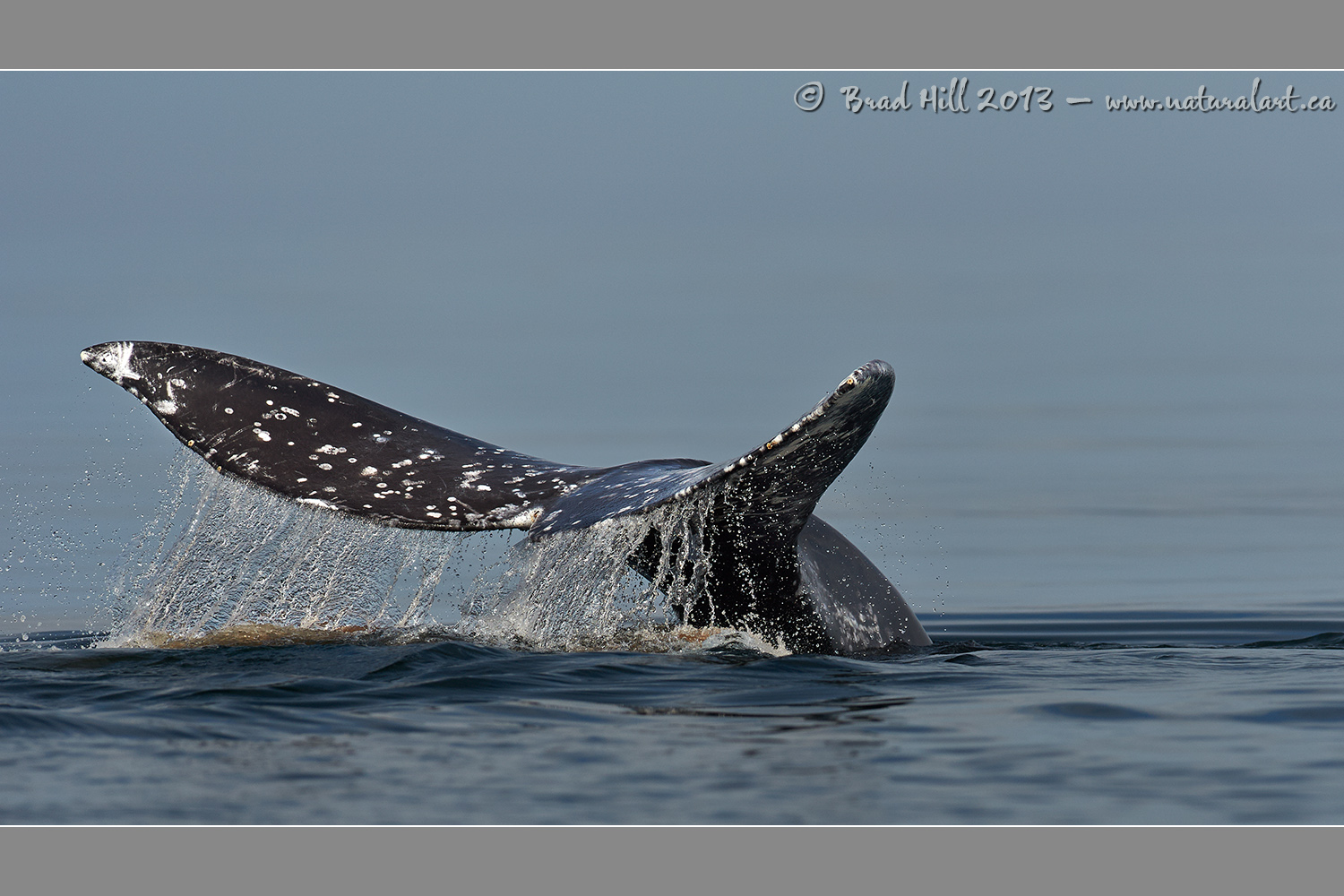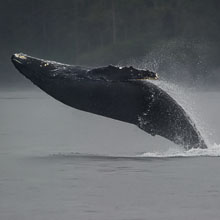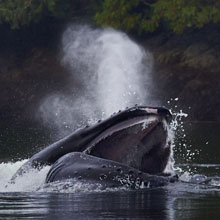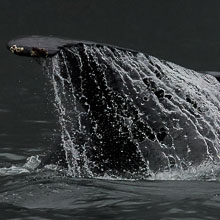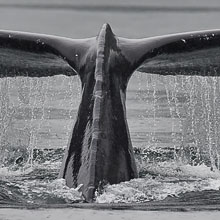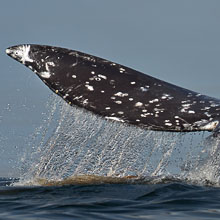Availability: Undetermined - Enquiries?
In the Field
A Whale's Tale. Northern Vancouver Island, BC, Canada. August 20, 2012.
Whale's tails are pretty fascinating things. The first time you see one up close it's hard not to be amazed at their size (regardless of the species). And, after you've seen a couple you start to notice differences between them. Different species have different shaped tails, and tend to use them a little differently. And, even within a single species there's a lot of variation in the appearance of the tails between individual whales. If fact, the differences in the tails between two whales of the same species are often significant enough that they are commonly used (sometimes in conjunction with other features) to identify known individuals. This mottled tail happens to be owned by a Gray Whale - a fairly common filter-feeding whale on North America's Pacific coast. The light marks on the tail are a indicator of "parasites past" - barnacles and the like are picked up in the southern end of their migration route (often the Baja area) and when the whales head north the parasites fall off in the colder waters, leaving scars all over the whale's body, including on its tail.
Assuming you're in the right place at the right time, getting a photo of whale's tail isn't that hard (way easier than getting a shot of its belly!). But getting a GOOD shot of whale's tail is definitely challenging. One way to get a more interesting shot is to (if you're lucky to be in EXACTLY the right place) get a close-up shot showing the fascinating detail - including scars - on the tail. And, if you're lucky enough to have water cascading off the tail (and you pick the right shutter speed) - well, all the better! And shooting the image from a very low level (like from a small Zodiac) doesn't hurt either!
Here's a higher resolution (2400 pixel) version of this Gray Whale's Tail/Tale:
• A Whale's Tale: Download 2400 pixel image (JPEG: 1.2 MB)
NOTES:
1. This image - in all resolutions - is protected by copyright. I'm fine with personal uses of it (including use as desktop backgrounds or screensavers on your own computer), but unauthorized commercial use of the image is prohibited by law. Thanks in advance for respecting my copyright!
2. Like all wildlife photographs on this website, this image was captured following the strict ethical guidelines described in The Wildlife FIRST! Principles of Photographer Conduct. I encourage all wildlife photographers to always put the welfare of their subjects above the value of their photographs.
3. This image was captured during my "Humpback, Orcas, Sea Lions & More" photo tour in August of 2012. Each year I offer trips into two different parts of the Great Bear Rainforest as well as one to photograph aquatic mammals and oceanscapes near the northern tip of Vancouver Island. And, in selected years, I also offer photo tours to locations to capture other highly sought-after subjects, such as various owl species of the boreal forest and wildlife of Canada's Arctic. Details about these trips can be found on the Photo Tours page of this website.
Behind the Camera
A Whale's Tale. Northern Vancouver Island, BC, Canada. August 20, 2012.
Digital Capture; RAW 14-bit format; ISO 450.
Nikon D4 paired with Nikkor 400mm f2.8G VR lens. Hand held. VR on and in normal mode.
1/1600s @ f5; no compensation from matrix-metered exposure setting.
At the Computer
A Whale's Tale. Northern Vancouver Island, BC, Canada. August 20, 2012.
RAW Conversion to 16-bit TIFF, including first-pass/capture sharpening using Capture One Pro Version 7. Two raw variants (processed from raw) differing by a total of 0.7 stops in exposure.
Photoshop adjustments included compositing the raw conversion exposure variants, selective minor tweaks to exposure, and selective sharpening for web output. Final tone tweaking performed using tonemapper/re-light tool in Lightzone.
Conservation
A Whale's Tale. Northern Vancouver Island, BC, Canada. August 20, 2012.
Ten percent of the revenue generated by this image will be donated to Raincoast*.
Species Status in Canada**: Special Concern (May 2004) - protected in Canada.
The Gray Whale (Eschrichtius robustus) has been driven locally extinct (i.e., extirpated) in Canada's Atlantic waters and is listed as a species of Special Concern in Pacific Waters. It is protected under the Species at Risk Act and a public awareness campaign has been created to assist in reducing the impact of human activities on the gray Whale. Brochures have been distributed to fishing lodges and park staff to expand the sightings network and motivate people to make behavioural changes that will benefit gray Whale populations. Additionally, workshops are held to educate kayak guides on proper whale watching guidelines.
Gray Whales are the sole species of the family Eschrichtiidae and differ in many ways from all the other baleen whales, including the fact that they're the only baleen whale that regularly feeds on the bottom of the ocean, normally in shallow, sandy areas. When feeding the gray Whale rolls onto one side until its head is parallel to the bottom and then acts like a giant vacuum cleaner (the suction is created through the movement of its large muscular tongue) sucking up marine invertebrates living at or just above the bottom.
Gray whales are mid-sized whales of approximately 10 to 15 meters in length and are mottled gray in colour, though concentrations of barnacles and whale lice can give their back a brownish or yellow/orange tint. They annually perform one of the longest migrations of any mammals, traveling over 10,000 km from summer feeding grounds in Arctic waters to shallow water lagoons off Baja California to breed. During this annual trip the grays encounter a diversity of conditions and jurisdictional boundaries, which complicates efforts at conservation.
*The Raincoast Conservation Society (and Foundation) is an effective and efficient organization that has been fighting for protection of this unique habitat. If you are looking for a meaningful way to contribute to the conservation of this amazing ecosystem, Raincoast will provide maximal "bang" for your conservation dollars.
**as determined by COSEWIC: The Committee on the Status of Endangered Wildlife in Canada












